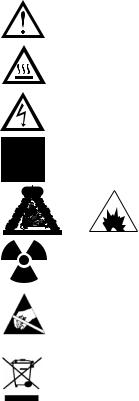Agilent Technologies 5975 User Manual

5975 Series
Mass Selective
Detectors
Site Preparation Guide





 Agilent Technologies
Agilent Technologies

Notices
© Agilent Technologies, Inc. 2008
No part of this manual may be reproduced in any form or by any means (including electronic storage and retrieval or translation into a foreign language) without prior agreement and written consent from Agilent Technologies, Inc. as governed by United States and international copyright laws.
Manual Part Number
G3170-90001
Edition
Second edition, January 2008
Printed in USA
Agilent Technologies, Inc.
5301 Stevens Creek Boulevard
Santa Clara, CA 95052
Acknowledgements
Microsoft® and Windows® are U.S. registered trademarks of Microsoft Corporation
Warranty
The material contained in this document is provided “as is,” and is subject to being changed, without notice, in future editions. Further, to the maximum extent permitted by applicable law, Agilent disclaims all warranties, either express or implied, with regard to this manual and any information contained herein, including but not limited to the implied warranties of merchantability and fitness for a particular purpose. Agilent shall not be liable for errors or for incidental or consequential damages in connection with the furnishing, use, or performance of this document or of any information contained herein. Should Agilent and the user have a separate written agreement with warranty terms covering the material in this document that conflict with these terms, the warranty terms in the separate agreement shall control.
Safety Notices
CAU TI ON
A CAUTION notice denotes a hazard. It calls attention to an operating procedure, practice, or the like that, if not correctly performed or adhered to, could result in damage to the product or loss of important data. Do not proceed beyond a CAUTION notice until the indicated conditions are fully understood and met.
WA RN ING
A WARNING notice denotes a hazard. It calls attention to an operating procedure, practice, or the like that, if not correctly performed or adhered to, could result in personal injury or death. Do not proceed beyond a WARNING notice until the indicated conditions are fully understood and met.
Site Preparation Guide
Contents
1 General Information |
|
|
||
Instrument Identification |
6 |
|
||
5975 MSD versions |
6 |
|
||
Important Safety Warnings 7 |
|
|||
Many internal parts of the MSD carry dangerous voltages 7 |
||||
Electrostatic discharge is a threat to MSD electronics 8 |
||||
Many parts are dangerously hot |
8 |
|||
Hydrogen Safety |
9 |
|
|
|
Chemical Safety |
10 |
|
|
|
Safety and Regulatory Certifications |
11 |
|||
Information |
11 |
|
|
|
Symbols |
12 |
|
|
|
Electromagnetic compatibility |
13 |
|||
Sound emission declaration 13 |
||||
Cleaning |
14 |
|
|
|
Recycling the Product |
14 |
|
||
2 Site Preparation |
|
|
Overview 16 |
|
|
Customer responsibility |
16 |
|
Agilent responsibility |
17 |
|
Other documentation |
19 |
|
Space and Weight Requirements |
20 |
|
Communications Requirements |
22 |
|
Telephone 22 |
|
|
Site LAN network 22 |
|
|
Electrical Requirements |
23 |
|
Site Preparation Guide |
3 |
Voltage ranges of major components |
23 |
||||
Power configurations |
24 |
|
|
||
Power requirements |
25 |
|
|
||
Power plugs and cord |
26 |
|
|
||
Other electrical considerations |
27 |
|
|||
Air Conditioning and Environmental Requirements 28 |
|||||
Temperature, humidity, and altitude |
28 |
||||
Airborne dust |
29 |
|
|
|
|
Exhaust venting 29 |
|
|
|
||
Fume (exhaust) hood |
|
30 |
|
|
|
Carrier and Reagent Gas Requirements |
31 |
||||
Regulators, tubing, and fittings |
32 |
|
|||
Laboratory Supply Requirements |
33 |
|
|||
Cleaning solvents |
33 |
|
|
|
|
Data system supplies |
33 |
|
|
||
Spare parts and consumables |
34 |
|
|||
Receiving the System |
37 |
|
|
|
|
Delivery and unloading |
37 |
|
|
||
Inspecting for damage |
37 |
|
|
||
Storage 38 |
|
|
|
|
|
Unpacking |
38 |
|
|
|
|
Installation and Verification |
39 |
|
|
||
Installation |
39 |
|
|
|
|
Verification |
39 |
|
|
|
|
Sensitivity specifications 40
A Power Cords
4 |
Site Preparation Guide |

5975 Series Mass Selective Detectors
Site Preparation Guide
1
General Information
Instrument Identification |
6 |
|
Important Safety Warnings |
7 |
|
Hydrogen Safety |
9 |
|
Chemical Safety |
10 |
|
Safety and Regulatory Certifications 11
Cleaning 14
Recycling the Product 14
This section provides information on how to identify specifically what type of MSD you are working with as well as how to properly clean and dispose of the instrument. Also included in this section are the “Important Safety Warnings” which list critical safety precautions for all users.
Agilent Technologies |
5 |

General Information
Instrument Identification
Each 5975 Series Mass Selective Detector (MSD) is identified by a unique 10-character serial number. This serial number is located on a label on the lower left side near the front of the instrument. On CI upgrades, a second serial number is located on the flow module.
When corresponding with Agilent Technologies about your instrument, be sure to include the model number and both full 10-character serial numbers.
Write the serial number of your 5975 MSD here for reference:
5975 MSD versions
Table 1 shows the kinds of 5975 MSDs available. The product number on the serial number label identifies your MSD.
Table 1 |
5975 MSD versions |
|
|
|
|
|
|
|
|
Model number |
Product number |
Pump type |
Ionization mode |
|
|
|
|
|
|
5975 VL MSD |
G3170A |
Diffusion |
Electron Impact (EI) only |
|
|
|
|
|
|
5975 inert MSD |
G3171A |
Standard turbo |
Electron Impact (EI) only |
|
|
|
|
|
|
|
|
G3172A |
Performance turbo |
Electron Impact (EI) only |
|
|
|
|
|
5975 inert XL MSD |
G3174A |
Performance turbo |
Electron Impact (EI) |
|
|
|
|
|
Negative Chemical Ionization (NCI) |
|
|
|
|
Positive Chemical Ionization (PCI |
|
|
|
|
|
This site preparation guide will refer to 5975 Series MSDs unless noted otherwise.
6 |
Site Preparation Guide |
General Information
Important Safety Warnings
Before moving on, there are several important safety notices that you should always keep in mind when using the 5975 Series Mass Selective Detector.
Many internal parts of the MSD carry dangerous voltages
If the MSD is connected to a power source, even if the power switch is off, potentially dangerous voltages exist on:
•The wiring between the MSD power cord and the AC power supply, the AC power supply itself, and the wiring from the AC power supply to the power switch.
|
With the power switch on, potentially dangerous voltages also exist on: |
|
|
• All electronics boards in the instrument. |
|
|
• The internal wires and cables connected to these boards. |
|
|
• The wires for any heater. |
|
|
All these parts are shielded by covers. With the covers in place, it should be difficult |
|
WA RN ING |
||
to accidentally make contact with dangerous voltages. Unless specifically |
||
|
||
|
instructed to, never remove a cover unless the detector, inlet, or oven are turned off. |
|
|
|
|
|
If the power cord insulation is frayed or worn, the cord must be replaced. Contact |
|
WA RN ING |
||
your Agilent service representative. |
||
|
||
|
|
|
|
Connecting the MSD to power sources that are not equipped with protective |
|
|
earth contacts creates a shock hazard for the operator and can damage the |
|
|
instrument. |
|
|
Interrupting the protective conductor inside or outside the MSD or |
|
|
disconnecting the protective earth terminal creates a shock hazard for the |
|
|
operator and can damage the instrument. |
|
|
Make sure the power cords supplied with the MSD are appropriate for your |
|
|
country and site before using them. Maintain easy access to the power cords |
|
|
so they can be disconnected during maintenance. |
Site Preparation Guide |
7 |
General Information
The use of incorrect or makeshift fuses or the short-circuiting of fuse holders creates a shock hazard for the operator and can damage the instrument. Replace fuses only with fuses of identical current rating and type.
Excessive fluctuations in the line voltage can create a shock hazard and can damage the instrument. Make sure the supply voltage does not fluctuate more than +5% or -10% from the rated voltage. This equipment must be installed in a Category II environment as defined in IEC 664.
Electrostatic discharge is a threat to MSD electronics
The printed circuit (PC) boards in the MSD can be damaged by electrostatic discharge. Do not touch any of the boards unless it is absolutely necessary. If you must handle them, wear a grounded wrist strap and take other antistatic precautions. Wear a grounded wrist strap any time you must remove the MSD covers.
Many parts are dangerously hot
|
Many parts of the MSD operate at temperatures high enough to cause serious |
|
|
burns. |
|
|
You should always cool heated areas of the MSD to room temperature before |
|
|
working on them. They will cool faster if you first set the temperature of the |
|
|
heated zone to room temperature. Turn the zone off after it has reached the |
|
|
setpoint. If you must perform maintenance on hot parts, use a wrench and |
|
|
wear gloves. Whenever possible, cool the part of the instrument that you will |
|
|
be maintaining before you begin working on it. |
|
|
Be careful when working behind the gas chromatograph (GC). During cool-down |
|
WA RN ING |
||
cycles, the GC emits hot exhaust which can cause burns. |
||
|
||
|
|
|
|
The insulation around the GC inlets, detectors, valve box, and the insulation cups is |
|
WA RN ING |
||
made of refractory ceramic fibers. To avoid inhaling fiber particles, we recommend |
||
|
||
|
the following safety procedures: ventilate your work area; wear long sleeves, |
|
|
gloves, safety glasses, and a disposable dust/mist respirator; dispose of insulation |
|
|
in a sealed plastic bag; wash your hands with mild soap and cold water after |
|
|
handling the insulation. |
|
|
|
8 |
Site Preparation Guide |
General Information
Hydrogen Safety
|
Hydrogen gas may be used as carrier gas, and/or as fuel for certain GC |
|
|
detectors. When mixed with air, hydrogen can form explosive mixtures. |
|
|
A detailed discussion of hydrogen safety appears in Chapter 1 of the Agilent |
|
|
5975 MSD Troubleshooting and Maintenance Manual. Read this material |
|
|
before using hydrogen with the MSD. |
|
|
When using hydrogen (H2) as the carrier gas or fuel gas, be aware that hydrogen |
|
WA RN ING |
||
|
gas can flow into the oven and create an explosion hazard. Therefore, be sure that |
|
|
||
|
the supply is off until all connections are made, and ensure that the GC inlet and |
|
|
detector column fittings are either connected to a column or capped at all times |
|
|
when hydrogen gas is supplied to the instrument. |
|
|
Hydrogen is flammable. Leaks, when confined in an enclosed space, may create a |
|
|
fire or explosion hazard. In any application using hydrogen, leak test all |
|
|
connections, lines, and valves before operating the instrument. Always turn off the |
|
|
hydrogen supply at its source before working on the instrument. |
|
|
|
|
|
The MSD cannot detect leaks in gas streams. For this reason, it is vital that column |
|
WA RN ING |
||
fittings should always be either connected to a column, or have a cap or plug |
||
|
||
|
installed. |
|
|
|
|
|
When using hydrogen gas, check the system for leaks as described by your |
|
|
local Environmental Health and Safety (EHS) requirements to prevent |
|
|
possible fire and explosion hazards. Always check for leaks after changing a |
|
|
tank or servicing the gas lines. Always make sure the vent line is vented into a |
|
|
fume hood. |
Site Preparation Guide |
9 |
General Information
Chemical Safety
WA RN ING |
The foreline pump exhaust and split vent exhaust will contain traces of the |
|
chemicals you are analyzing. These could potentially be toxic. Vent the foreline |
||
|
||
|
pump exhaust and split vent exhaust outside your laboratory or into a fume hood. Be |
|
|
sure to comply with all local environmental regulations. |
|
|
|
10 |
Site Preparation Guide |

General Information
Safety and Regulatory Certifications
The 5975 Series MSD conforms to the following safety standards:
•Canadian Standards Association (CSA): CAN/CSA–C22.2 No. 61010–1–04
•CSA/Nationally Recognized Test Laboratory (NRTL): UL 61010–1
•International Electrotechnical Commission (IEC): 61010–1
•EuroNorm (EN): 61010–1
The 5975 Series MSD conforms to the following regulations on Electromagnetic Compatibility (EMC) and Radio Frequency Interference (RFI):
•CISPR 11/EN 55011: Group 1, Class A
•IEC/EN 61326
•AUS/NZ 
This ISM device complies with Canadian ICES-001. Cet appareil ISM est conforme a la norme NMB—001 du Canada.
The 5975 Series MSD is designed and manufactured under a quality system registered to ISO 9001.
Information
The Agilent Technologies 5975 Series MSD meets the following IEC (International Electro-technical Commission) classifications: Equipment Class I, Laboratory Equipment, Installation Category II, Pollution Degree 2.
This unit has been designed and tested in accordance with recognized safety standards and is designed for use indoors. If the instrument is used in a manner not specified by the manufacturer, the protection provided by the instrument may be impaired. Whenever the safety protection of the MSD has been compromised, disconnect the unit from all power sources and secure the unit against unintended operation.
Refer servicing to qualified service personnel. Substituting parts or performing any unauthorized modification to the instrument may result in a safety hazard.
Site Preparation Guide |
11 |

General Information
Symbols
Warnings in the manual or on the instrument must be observed during all phases of operation, service, and repair of this instrument. Failure to comply with these precautions violates safety standards of design and the intended use of the instrument. Agilent Technologies assumes no liability for the customer’s failure to comply with these requirements.
See accompanying instructions for more information.
Indicates a hot surface.
Indicates hazardous voltages.
Indicates earth (ground) terminal.
Indicates potential explosion hazard. |
or |
Indicates radioactivity hazard.
Indicates electrostatic discharge hazard.
Indicates that you must not discard this electrical/electronic product in domestic household waste.
12 |
Site Preparation Guide |
General Information
Electromagnetic compatibility
This device complies with the requirements of CISPR 11. Operation is subject to the following two conditions:
•This device may not cause harmful interference.
•This device must accept any interference received, including interference that may cause undesired operation.
If this equipment does cause harmful interference to radio or television reception, which can be determined by turning the equipment off and on, the user is encouraged to try one or more of the following measures:
1Relocate the radio or antenna.
2Move the device away from the radio or television.
3Plug the device into a different electrical outlet, so that the device and the radio or television are on separate electrical circuits.
4Make sure that all peripheral devices are also certified.
5Make sure that appropriate cables are used to connect the device to peripheral equipment.
6Consult your equipment dealer, Agilent Technologies, or an experienced technician for assistance.
7Changes or modifications not expressly approved by Agilent Technologies could void the user’s authority to operate the equipment.
Sound emission declaration
Sound pressure
Sound pressure Lp < 70 dB according to EN 27779:1991.
Schalldruckpegel
Schalldruckpegel LP < 70 dB am nach EN 27779:1991.
Site Preparation Guide |
13 |
General Information
Cleaning
To clean the unit, disconnect the power and wipe down with a damp, lint-free cloth.
Recycling the Product
For recycling, contact your local Agilent sales office.
14 |
Site Preparation Guide |
